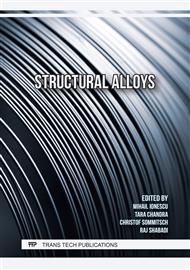p.65
p.73
p.79
p.85
p.91
p.97
p.103
p.109
p.115
Effect of Process Condition and Test Environment on Tensile Properties in Cold-Rolled Al-Cu-Mg Alloys
Abstract:
Severe plastic deformation processing and subsequent aging treatment have been known to be effective for achieving higher strength than the conventional aging treatment in aluminum alloys. This study prepared the Al-Cu-Mg-based alloy sample, Al-5.3Cu-2.8Mg (mass%). The alloys were solution treated at 480, 495 and 505°C, and cold-rolled by 90%. The effect of process condition and test environment on tensile properties in cold-rolled Al-Cu-Mg alloys was investigated. Results confirm that strength and ductility were improved with increasing the solution heat treatment temperature regardless of test environment. 0.2% proof stress and ultimate tensile strength were higher than aging treatment specimens, but elongation to failure was lower than aged one. Hydrogen embrittlement susceptibility increased with increasing solution treatment temperature. Ductile fracture with many dimples is observed in both cold-rolled and aged specimens. Second-phase particles were observed at the bottom of the dimples. There was no significant difference in fracture surface between the different test environments.
Info:
Periodical:
Pages:
91-96
Citation:
Online since:
December 2023
Authors:
Price:
Сopyright:
© 2023 Trans Tech Publications Ltd. All Rights Reserved
Share:
Citation:



